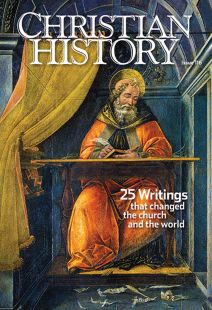Restoring order, restoring life
Order Christian History #116: Twenty-Five Writings that Changed the Church and the World in print.
Subscribe now to get future print issues in your mailbox (donation requested but not required).
WHEN THINGS ARE IN DISARRAY, God brings order out of chaos. Within about 60 years of each other, God used Benedict of Nursia and Pope Gregory to do just that. Benedict’s Rule for monastic community life and Gregory’s Book of Pastoral Rule both intended to bring new life where the church was in decline.
A new way of life
As a teenager young Benedict (480–547), fed up with the immorality of Rome, began living as a solitary monk. Years later, with a growing following, Benedict grew convinced that a new way of learning and living would stem deterioration in both church and society. He constructed a rule of life around 530 to guide a monastic community he called a “school for the Lord’s service.” The communities that took his Rule as the way to order their lives together all preserved knowledge in the culture and advanced spirituality in the church. The effect of Benedict’s Rule ripples from his time into our own, where both traditional monastic communities and the movement called the “new monasticism” still order their lives together by its wisdom.
Gregory (540–604) became pope in 590. He believed that the humility and selfless service of monks stood in stark contrast to that of the church’s bishops, and his Book of Pastoral Rule, completed within months of him becoming pope, sought to inspire bishops to exemplify holy character, live lives of service, and offer spiritual guidance to priests and congregations. Gregory’s counsel continues to shape godly ministry—for bishops, pastors, and laity as well.
Both these ancient documents offer the potential to restore the personal and social order so often lacking in today’s world. Like Benedict and Gregory, we sometimes feel we are in a period where widespread disarray compounds confusion.
In Benedict we find a life-giving interplay between worship and work, and in Gregory we discover authenticity when we live among others as peers, with integrity and with the willingness to guide and be guided. Drawing from his own reading of Benedict and Gregory, John Wesley (see “‘Not concerning the heart but the life,’” pp. 36–37) would call this “watching over one another in love.” Benedict and Gregory give us the potential to bring the same order and new life to our time as they brought to their own. CH
This article is from Christian History magazine #116 Twenty-Five Writings that Changed the Church and the World. Read it in context here!
By Steve Harper
[Christian History originally published this article in Christian History Issue #116 in 2015]
Steve Harper is a retired professor of spiritual formation and elder in the United Methodist Church.Next articles
Paying back the debt
Anselm’s Why God Became Man [#17] answered an age-old question
Edwin Woodruff TaitIntellect that illuminates Christian truth
Thomas Aquinas’s Summa Theologiae [#2] explained Christianity’s rational basis
Garry J. CritesFollowing Jesus above all
The Imitation of Christ [#10] gave us a model for prayerful living
Paul W. ChilcoteSupport us
Christian History Institute (CHI) is a non-profit Pennsylvania corporation founded in 1982. Your donations support the continuation of this ministry
Donate




